본문
The harmony of the sound of a temple block and beautiful scenery <The temples of Jejudo>
별점(별점없음)
Go on a journey to cultivate a prudent and strong heart that will not easily be swayed. Have an indescribably warm, relaxing moment that will save you from days troubled by anxiety.
Review
0
Lookup
6,826
Share SNS
2
- The harmony of the sound of a temple block and beautiful sceneryThe temples of Jejudo
On a day when you suddenly long for meditation, you go in search of silence. You escape from places crowded with people and arrive at a temple where the solemn and gentle melody of a wind chime tickles the ears. Visit a temple on Jejudo, where the sounds of nature ease your mind and the island’s splendid scenery rejuvenates your eyes. Traveling relieves the mind distressed from daily life and refreshes you to keep going on. If you wish each moment of your travel to be a time to heal, you should sometimes visit a place where you can fully rest your mind. Go on a journey to cultivate a prudent and strong heart that will not easily be swayed. Have an indescribably warm, relaxing moment that will save you from days troubled by anxiety.
Geumnyongsa Temple is the perfect place for pursuing Zen meditation training, as it is located in Gimnyeong-ri on the east side of Jeju, where flat rocks and pine trees create a picture of a yellow dragon and a blue dragon in harmony. Below the temple lies a labyrinthine cave, where spring water originating from Hallasan Mountain flows to Gimnyeong Seongsegi Beach, acting as a village spring on its way. The roots of Geumnyongsa date back to a Buddhist prayer hall established by a female Buddhist, Kim Yeon-hwa, in 1930. After nearly 50 years, when the hall and the monk’s dormitory came to the brink of ruin, a monk named Jajae Hyeondo came and established Daeungjeon Hall in 1975, paving the way for a proper temple. Adhering to his life philosophy, “act with a clear conscience,” and family motto, “practice true love,” Hyeondo has spent his entire life as a disciple preaching the teachings of Buddha and engaging in the international propagation of Buddhism to realize the pure land.

Geumnyongsa Temple was designated as a temple stay program operation temple in 2016 and offers two types of temple stay programs. There is a one-day program for about 3-4 hours with a guided tour of the temple, and then based on your choice, you can participate in threading 108 beads for a Buddhist rosary, have tea with a monk, meditate with the waves, stroll along the beach, walk on the Jeju Geo Trail or Olle Route 20, or make a lotus lantern. The other is a rest-type temple stay called “Buddha swimpang.” While swimpang is a Jeju language for shelter, the second program lets you act freely — for example, walk along the beach, meditate, or read books — except for the orientation time, Buddhist service, and making offerings to Buddha. If you want to experience Geumnyongsa Temple’s temple stay program, make a reservation online or by phone for one of the programs before visiting.

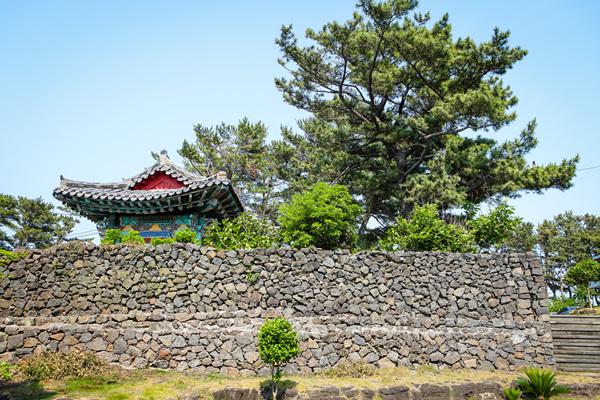

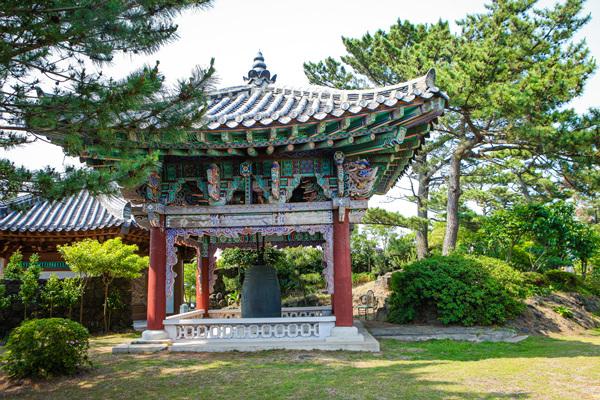
Pyeonghwatongil-bulsaritapsa Temple in Jocheon-ri, Jocheon-eup, Jeju-si, was founded to carry on the efforts of great monks Heoeungdang Bou and Hwanseong Jian to spread the teachings of Buddha and pray for the nation’s reunification and world peace by transcribing the Saddharmapundarika Sutra (Lotus Sutra), which is an act of practicing good deeds in Buddhism. These two monks, who dedicated themselves to the revival of Buddhism during its suppression by the Joseon Dynasty, were banished to Jejudo and died as martyrs. Unlike other typical temples, Buddha sarira stupa here was built following a Southern Buddhist architectural style. This stupa, which resembles the Sanchi stupa in India, indicates that it was built with prayers to and belief in the Relics of Shakyamuni Buddha. The stupa is a 33-meter-high three-story building which represents the heaven of the 33 gods in Buddhism. To symbolize the complete peace and happiness of the universe, the first floor was built in a circle and covers 360 pyeong (1,190㎡), a number that represents the angle of a circle. Moreover, the 32 pillars on the first floor stand for the 32 images of Avalokitesvara Bodhisattva.
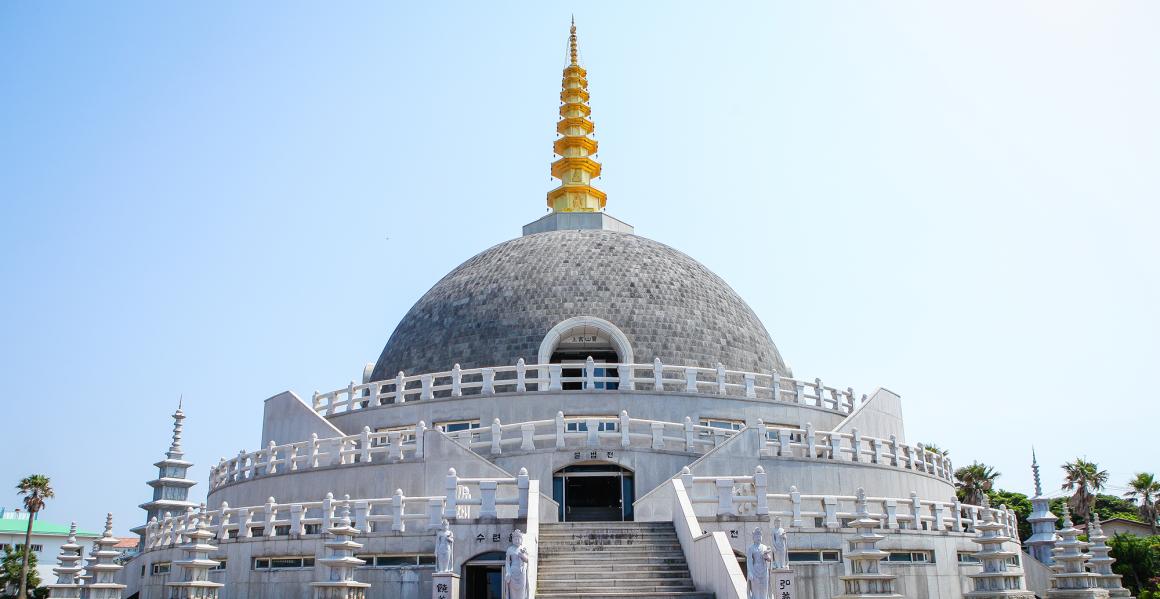
The second floor is 280 pyeong (924㎡) in extent. The eight pillars represent the Noble Eightfold Path (the path of Buddhist practices leading to liberation from samsara), and the ceiling is covered with patterns of the dharmachakra (the dharma wheel), which symbolizes the teachings of Buddha. The third floor has an area of 108 pyeong (356㎡), representing the 108 earthy desires, and it means that everyone is to free themselves from the earthy desires and enter the world of Buddha in the sanctuary. Pyeonghwatongil-bulsaritapsa Temple, which is characterized as a temple practicing a transcription of the Saddharmapundarika Sutra (Lotus Sutra) and as a Buddhist sacred ground, has held an enshrinement ceremony for the transcription of the Lotus Sutra every year since its establishment. As of 2007, about 200,000 sutra transcriptions have been written by Buddhists from all over the nation and about 50 pagodas enshrine the transcriptions. The third floor offers a full view of the Buddhas, transcription pagodas, and the beaches of Jocheon. As you can see unique religious structures along with the vast sea here, this is one of the temples favored by many tourists.




This small Jogye Order temple, which resembles a quiet beach, is close to Moseulpo Port on the island’s west side. Established by anti-Japan activist and monk Gang Chang-Gyu on June 7, 1943, the temple vividly symbolizes the modern history of Jeju including the history of its resistance to Japan and Buddhism during the Japanese colonial era. Founder Gang Chang-Gyu was one of the leaders of the Beopjeongsa Anti-Japanese Resistance Movement who led the people on the day of the revolt. Due to his actions, Gang spent 5 years and 11 months in prison, the longest time among the monks who joined the movement. At the entrance to the temple there is two-story Iljumun Gate, with a bell tower on the second floor. In this small temple, the monk’s dormitory is beside Daeungjeon Hall. The temple was built in 1967, adapting to nature by using resources such as Jeju’s characteristic basalt to build the walls. As a result, the temple has a unique and simple appearance.
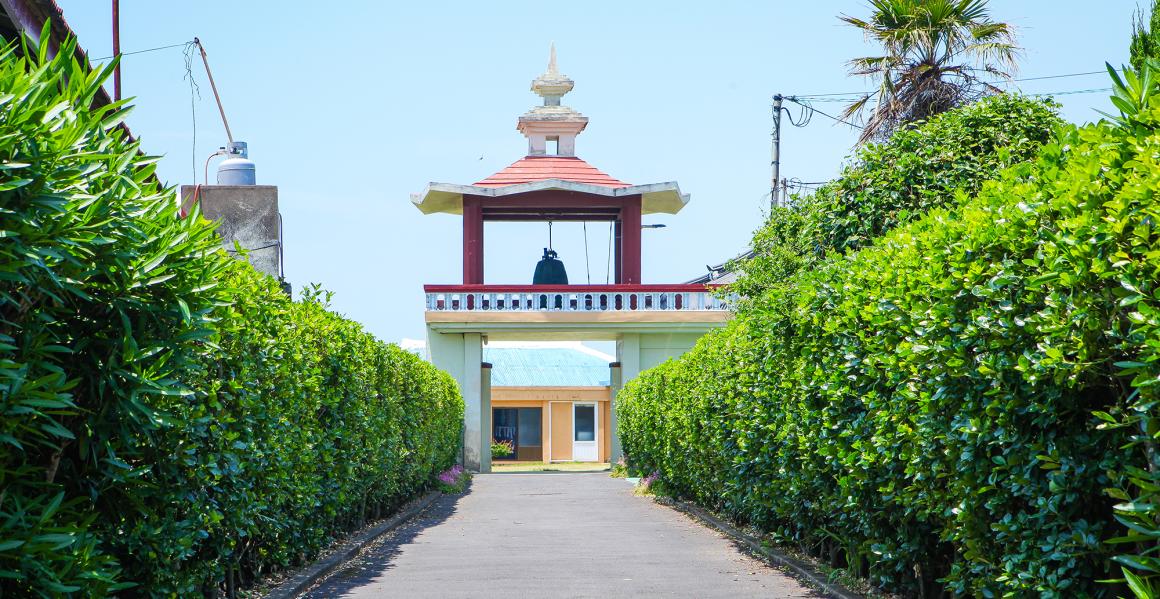
While still preserving its appearance, the plain sanctuary without any ornamental paintings recently enshrined a hanging scroll, a painting of Buddhist deities, a canopy for the Buddhas, etc. Inside the shrine, Shakyamuni Buddha is in the center as the main Buddha, and seated beside him are Ksitigarbha Bodhisattva and Avalokitesvara Bodhisattva, the supporting Buddhas. On the upper left side in the sanctuary, a Wooden Seated Bodhisattva, registered as Tangible Cultural Property of Jeju-do No. 20 on September 9, 2004, is housed in a glass case. This wooden Bodhisattva, sculpted in 1534, well reflects the style of Buddhist statues in the early Joseon Dynasty. It includes relics from that era, making it academically and culturally more valuable with its accurate time of creation. How about enjoying both cultural values and nature in Seosansa Temple, where the waters of Moseulpo Port and the blue sky meet?
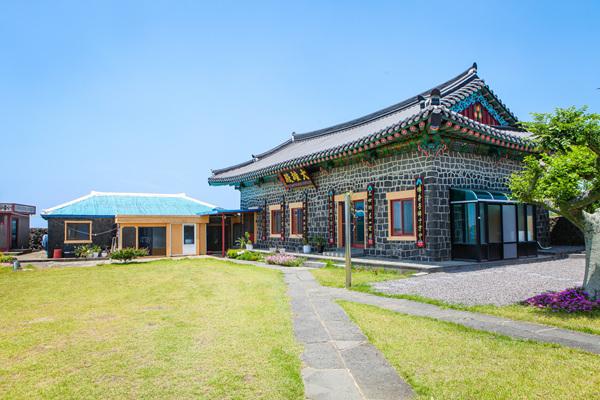

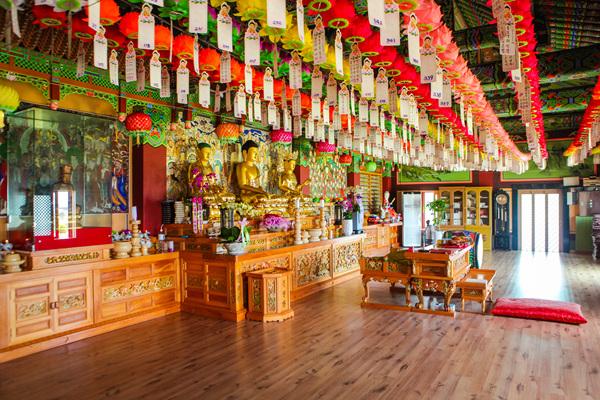

Seondeoksa Temple is one of the few traditional Buddhist temples on Jejudo. Just as traditional temples were built between the slopes of a mountain, Seondeoksa is embraced in the arms of the spiritual Hallasan Mountain, creating a sight not seen in other regions. As it preserves the traditional style, Seondeoksa Temple was designated as Local Tangible Cultural Heritage of Seogwipo-si No. 3 in 2005, and the temple’s Daejeokgwangjeon Hall was registered as Cultural Properties of Jeju-do No. 8 in the same year. Considering that the temple’s three different editions of the Saddharmapundarika Sutra (Lotus Sutra) passed down from the master monk Goam were also designated as Tangible Cultural Property of Jeju-do No.19, Seondeoksa Temple is basically a repository of the island’s Buddhist heritage. While the Iljumun Gate in most traditional Buddhist temples directly faces Daeungjeon Hall, the one in Seondeoksa Temple faces the top of Hallasan Mountain. If you pass Iljumun Gate, you will find Geumgangmun Gate with its two Deva kings glaring at you.
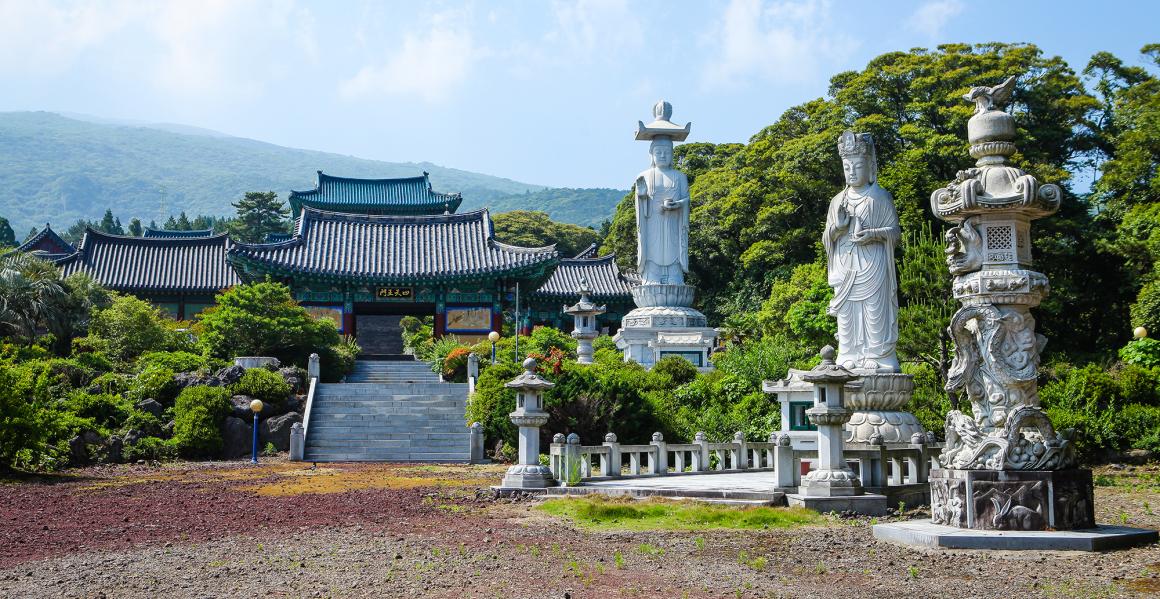
The sanctuary of Seondoeksa Temple enshrines not only a hanging scroll made by Living National Treasure Song Bong-gu and his pupils, a painting of Buddhist deities, and a painting of 500 Arhats, but also a bell and a gong recreated according to United Silla’s wax casting method for the first time in the country by Sungjongsa Company’s Won, Kwang-Sik, who is Important Intangible Cultural Property No. 112. Seondeoksa Temple recently launched an experience program, an enhanced version of a temple stay program, which is a healing tour through the stories of the temple’s cultural properties. The temple culture experience program, “Finding the stories of the Lotus Sutra embedded in Hallasan Mountain,” is held on the third Sunday morning of every month. This healing program for modern people uses the Saddharmapundarika Sutra (Lotus Sutra), one of the Sutras of Mahayana Buddhism. While the temple runs a Lotus Sutra transcription study group, Seondeoksa Temple offers an opportunity to heal one’s mind with the Lotus Sutra once a month.


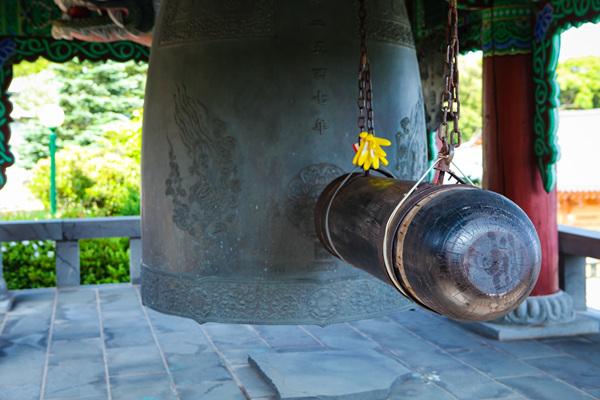

Yakcheonsa Temple of the Jogye Order has the largest Buddhist sanctuary in the East, and a fantastic view of Jeju’s coast. The moment you enter the temple, the grand sanctuary, called Daejeokgwangjeon Hall, surprises you, but it’s too soon to be surprised. The sanctum, which is 25 m high inside, has three floors. On each side of Daejeokgwangjeon Hall, which enshrines the Vairocana Buddha, there is a Bhaisajyaguru Buddha and Amitabha Buddha, and behind them is a wooden panel with Buddhist images in relief, which is known to be a piece that was difficult to make and thus is rarely seen. This panel, which is said to be modeled after the Wooden Panel with Buddhist Images in Relief in Daeseungsa Temple in Mungyeong-si, Gyeongsangbuk-do, is highly praised for the effort and skills that went into making it. The four pillars supporting Daejeokgwangjeon Hall are carved with the images of a yellow dragon and a blue dragon holding a magic pearl in their mouths. On the second floor of the hall, 80,000 Buddhas made by Buddhists who also donated to the establishment of the temple are on display.

On the third floor, there are five Rotating Sutra Cases that Buddhists spin to accumulate virtuous deeds. Yakcheonsa Temple is also a place where not only Buddhists but also many tourists coming to Jeju visit to make wishes. As a cornucopia of traditional Korean culture and a maintainer of original Buddhist culture, Yakcheonsa Temple gives everyone including teenagers and children an opportunity to experience daily life in a temple and a life like an ascetic with its temple stay program. The program includes basic activities such as learning temple manners and participating in a Buddhist service, and various other activities including practicing Buddhist asceticism, experiencing temple culture, and experiencing Jeju firsthand. Taking time to rest and enjoy various programs that offer a decent experience of traditional culture gets you a step closer to finding the true you. So, wouldn’t it be more meaningful to have this sort of time in the middle of your trip?
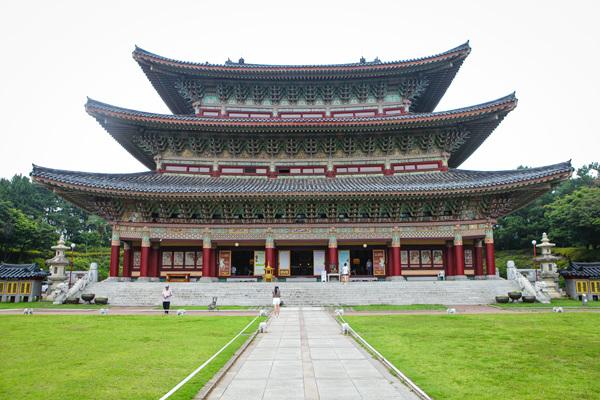

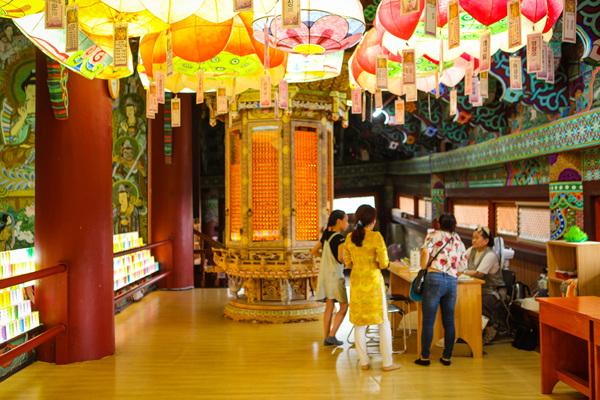
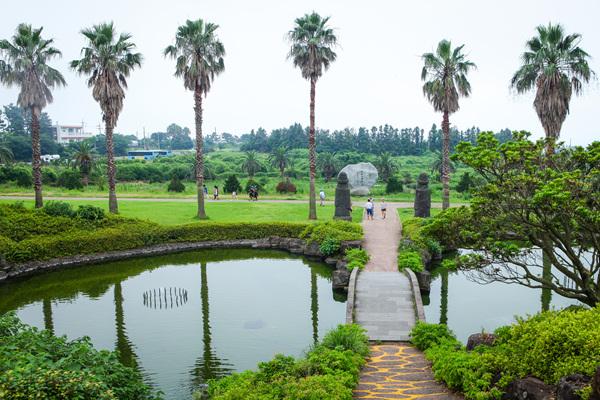
- Notice
- 2018-11-26
- ※ Unauthorized use of the content above (text, photos and videos) is prohibited and subject to copyright by the Jeju Tourism Organization.